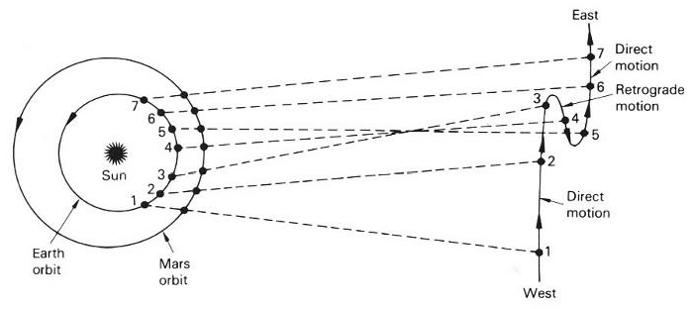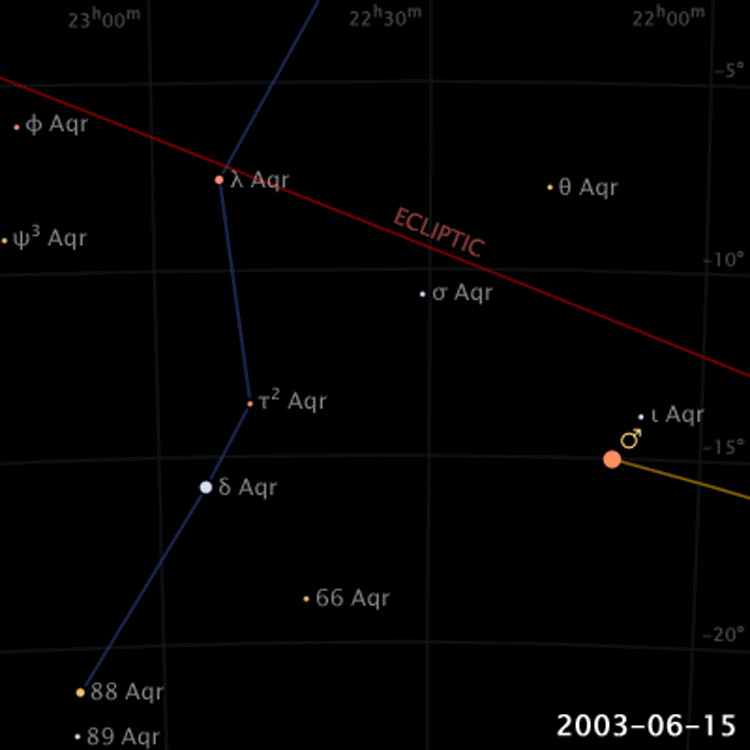|
Introduction
Most of the rotational and orbital motions in the solar system are in the same "eastward" direction. Motions in this direction are referred to as direct motions, while motions in the opposite direction are referred to as retrograde. There are three types of retrograde motion commonly referred to in astronomy:
Retrograde motion: The most commonly discussed "retrograde" motion is the apparent backward motion of a planet caused by its being lapped by another planet, or vice-versa. Both planets move in a direct (eastward) motion around the Sun, but the planet with the inside (smaller) orbit moves faster than the planet on the outside (larger) orbit, and when it passes the slower-moving planet, each sees the other one as apparently moving backwards relative to its usual motion around the sky. In this "retrograde" motion, neither planet is actually moving backwards; it only appears that way during the time that one laps the other.
Retrograde revolution: This refers to an orbital motion which is really backwards relative to normal orbital motions. No planet has a retrograde orbital motion, but some of the moons of the outer planets move backwards relative to the general motion of the other moons of those planets, and many comets have retrograde revolution.
Retrograde rotation: This is a rotational motion which is backwards relative to the orbital motion that an object has. All of the planets move around the Sun in a direct (eastward) direction, but three of them (Venus, Uranus and Pluto) rotate in a retrograde (westward) direction, and are said to have a retrograde rotation. Do not confuse revolution, or motion around an orbit, with rotation, or turning about an axis. Even though some planets have retrograde rotation, no planet has retrograde revolution. All the planets go around the Sun in the same (eastward) direction.
Retrograde Motion
(the "current" iteration referred students to their textbook, but the next iteration will replace that with a proper discussion)

(NASA SP-4212)
Retrograde motion of Mars. Under normal circumstances the planet appears to move to the East (upwards in the diagram), but when it is being overtaken by the Earth our faster motion makes Mars appear to be going backwards (downwards in the diagram). The normal motion is called direct motion, and the backwards motion is called retrograde motion. (Unfortunately, the positions of the planets in the left part of the diagram are very badly shown, making this diagram less useful than it could be, so it will be replaced with a better one at a later date. In particular, the diagram incorrectly shows Mars moving further and faster than the Earth in some parts of their orbits, which is impossible. On the average, the Earth moves nearly 24% further and faster than Mars in any given period of time. If Mars is near perihelion it does move faster than usual, but only about 10% faster, so it never moves around the Sun faster than the Earth.)

The motion of Mars during its retrograde motion of 1965.As noted in the diagram, such motion occurs at opposition, when Mars is opposite the Sun in the sky, and rises near sunset. (slightly modified from NASA SP-4212)

The retrograde motions of Mars and Uranus in 2003 (Tunc Tezel, apod031216)
A composite image created by superimposing images taken on twenty-nine different dates. In the illustration above Mars' images form a large loop, because its orbit is somewhat tilted and it moves relatively fast. Uranus' images (the fainter line of dots above Mars) form a more compact straight-line pattern, because it moves far more slowly in its much larger orbit and its orbit isn't tilted as much relative to ours. In each "loop" the planet appears to move to the east (from right to left) prior to opposition (when it is in the opposite direction from the Sun), slows down and reverses its path when near opposition (the middle of the loop), then resumes its eastward motion after passing opposition. As the planets stop moving east and start moving west their motion slows and may even appear to stop if they have a more-or-less straightline motion. As a result, the ends of the retrograde motion are referred to as "stationary" points. In the image, this is represented by the fact that the dots are relatively close together near the stationary points, and further apart elsewhere.
The illustration below is an animation of the retrograde motion shown above. The position of Mars is shown every other day (as shown by the date in the lower right corner), along with the trail traced out by the planet over time. Note that as the animation begins Mars is moving rapidly toward the left. As it approaches the left (eastern) side of the retrograde loop it slows down, and is moving slowest at the "stationary" point which defines the left end of the loop. It speeds up as it passes from left to right (in westward or retrograde motion), only to slow down again as it nears the right (western) stationary point. After passing that point the planet resumes its normal eastward motion, at a faster and faster pace. This can also be seen in the photograph above, in that the dots representing the position of the planet on different dates are further apart where it is moving faster, and closer together where it is moving slower; but because some nights were cloudy the spacing of the dates is not uniform, and some dots are further apart or closer together than they would be if every date could be shown. In the animation below, that is not a concern. Note: The first time the animation plays it may pause at times, while the rest of the file loads. When the animation repeats the pauses should disappear.

In the illustration below, as in the ones above, Mars' motion slows as it approaches a stationary point, speeds up and then slows down again as it goes through retrograde motion, then speeds up after passing the second stationary point. But unlike the retrograde loop observed in 2003, the 2005 opposition produced an ess-shaped motion relative to the stars. Which of the two types of retrograde motion occurs depends upon where the planet is, relative to the nodes of its orbit (the directions as seen from the Sun, where the plane of the planet's orbit crosses the plane of our orbit). If the planet is near a node, heading either upward or downward during the retrograde motion, an ess shape is produced. If the planet is near the top or bottom of its orbital motion (heading up and then downward, or down and then upward) during the retrograde motion, a loop is produced.

The retrograde motion of Mars in 2005; the Pleiades are seen at upper left (Tunc Tezel, apod060422)A composite image created by superimposing images taken on 35 different dates, separated from each other by about a week.
Retrograde Revolution
(to be added later)
Retrograde Rotation
All of the planets move around the Sun in the same eastward direction. Most of them also rotate in an eastward direction, but three of them (Venus, Uranus and Pluto) rotate to the west. As a result we say that they have a retrograde rotation. This is indicated, in discussion the rotation period of a planet, either by placing an "R" after the period or a minus sign in front of it. Either way is satisfactory for telling the reader that the motion is retrograde, but if the rotation period is used in a calculation, the minus sign is always used to ensure that the results of the calculation are correct.
Keep in mind when reading about objects which have retrograde rotation, that this only refers to the way in which they turn around their own axis of rotation. It has nothing to do with their orbital motion. Regardless of how they rotate, every planet orbits the Sun in the same (eastward) direction.
The following is a brief discussion of retrograde rotation (to be explained more fully at a later date).
Direct and Retrograde Rotations
  |
Direct rotation (on the left) and retrograde rotation (on the right).
In direct rotation, the rotation of the planet is in the same direction as its orbital motion.
In retrograde rotation, the rotation of the planet is in the opposite direction to its orbital motion.
In the diagram on the left a planet revolves around the Sun in an eastward direction, and also rotates in an eastward direction, so that the direction of the rotation and revolution are in the same sense (in this diagram, counter-clockwise). As a result, the stars (and the Sun) would move westward across the sky, rising in the east and setting in the west as the planet rotates, while the Sun gradually drifts to the east among the stars as a result of the planet's orbital motion. This situation is referred to as direct rotation.
In the diagram on the right a planet revolves around the Sun in an eastward direction, but rotates in a westward or retrograde direction, so that the direction of the rotation and revolution are in the opposite sense (in this diagram, counter-clockwise for the eastward revolution, and clockwise for the westward rotation). This would cause the Sun and stars to move eastward across the sky, rising in the west and setting in the east as the planet rotates. However, the Sun would still drift in the SAME direction (eastward) relative to the stars from day to day. This situation is referred to as retrograde rotation. Retrograde rotation affects the direction that the sky seems to turn, but it does NOT affect the way in which the Sun moves among the stars.
In some circumstances, such as when we want to compare the rotation period of a planet to the length of its day, we need to do a little arithmetic. For that arithmetic to work properly, it is necessary to distinguish planets which have direct rotation from those which have retrograde rotation. We define the rotation period of the planet as the time that it takes for it to rotate to the east. If it rotates in that way (has direct rotation), we consider the rotation period to be a positive number. If it rotates in the other direct (has retrograde rotation), we would have to run time backwards to see it rotate to the east, so we consider the rotation period to be a negative number and we either place a minus in front of the period (as shown below), or an "R" (for retrograde) after it.

The tilts of the planets.
For Venus, Uranus and Pluto the tilt is more than 90 degrees,
but can also be expressed as a negative number which is less than 90 degrees.
|